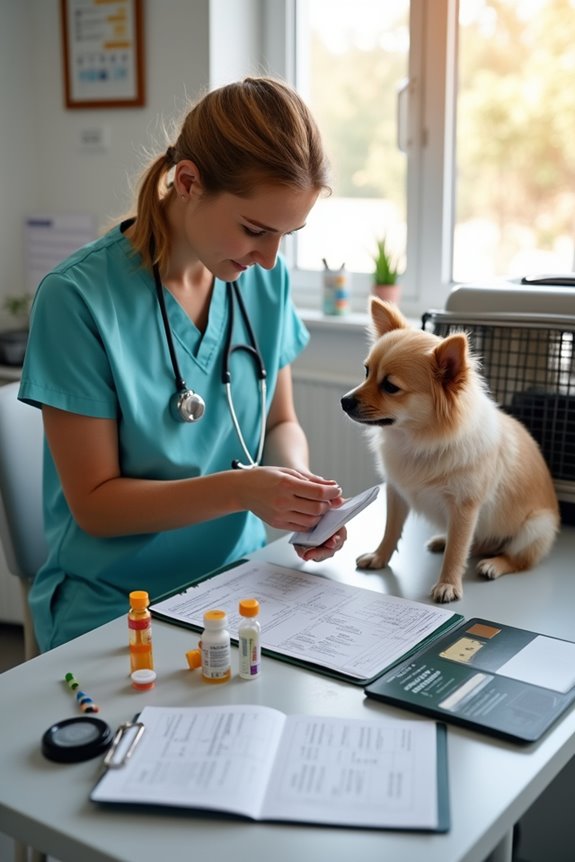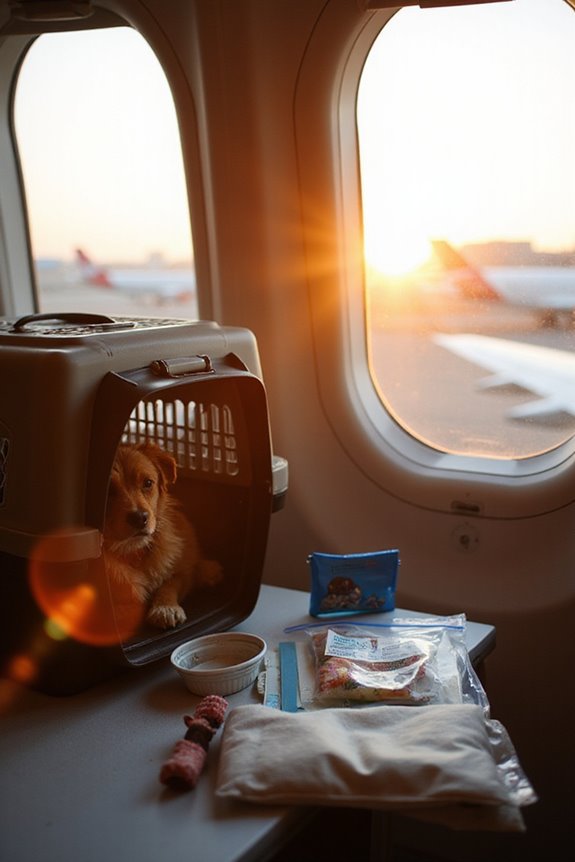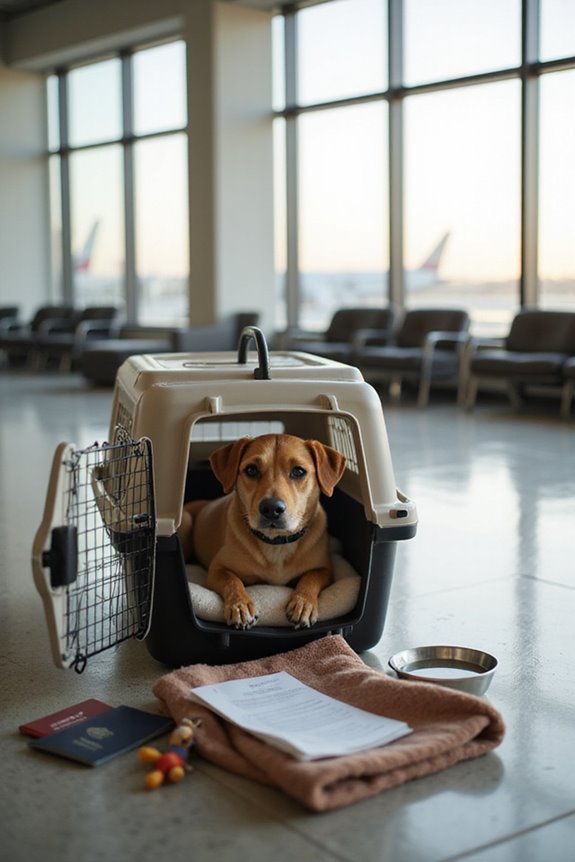Preparing my pet for air travel can feel like gearing up for an adventure! First, I check airline policies, ensuring I’m clear on fees and carrier size limits. I make sure my furry friend’s health documents are in order, with up-to-date vaccinations. I also pick a comfy, airline-approved carrier where they can curl up. Finally, a little prep for emergencies—like a first aid kit—goes a long way. Stick around for more tips on making this trip a breeze!
Key Takeaways
- Confirm your pet meets airline criteria for size, age, and breed before booking the flight.
- Obtain a Certificate of Veterinary Inspection within 10 days of travel, documenting health status and vaccinations.
- Choose a soft-sided carrier that fits under the seat, ensuring it’s well-ventilated and leak-proof.
- Organize health documentation and all necessary travel documents to avoid complications at the airport.
- Prepare an emergency kit with essentials like first aid supplies, fresh water, and important contact numbers.
Understanding Airline Pet Travel Policies

When it comes to flying with your furry friends, it can feel a bit overwhelming, especially if you’re not sure what the airline’s policies are. I remember booking my first flight with my dog, and I had to dive deep into airline restrictions and requirements. Most airlines are pretty picky about in-cabin pets, usually allowing only cats and dogs, and of course, there are pet fees to take into account, which can add up quickly—think $100 to $150 per leg of your journey!
I was shocked by size limits too; those soft-sided carriers aren’t just for style; they must fit under the seat. So, knowing these details ahead of time can really save you from some travel headaches!
Ensuring Health and Vaccination Compliance

Preparing your pet for air travel can feel like a challenging task, especially when it comes to health and vaccination requirements. Trust me, getting a Certificate of Veterinary Inspection is a must. Your furry friend needs to see the vet within 10 days of your flight. This certificate confirms your pet’s health status and details their vaccination timelines. Rabies, distemper, and parvovirus are typical must-haves, and don’t forget to pack a valid vaccination record. Some countries impose extra requirements, so it’s essential to know the rules. Just last year, I nearly forgot this, and my pup almost faced quarantine! Keeping all health documentation organized can make your journey smoother and more enjoyable for both of you.
Choosing the Right Travel Carrier

After mapping out the health and vaccination requirements for air travel, the next big task is picking the right travel carrier for your furry companion. It’s essential to choose a carrier that fits under the seat in front of you, usually around 18 inches long, so your pet can cozy up and feel safe. Soft-sided carriers are my favorite; they’re flexible and easier to stash. But don’t forget about ventilation! Make sure there’s enough airflow through the carrier to keep your pet comfortable during the flight. Plus, you want it to be leak-proof because, well, accidents happen. Always double-check airline regulations because each carrier’s design and size needs to meet specific compliance standards. Happy travels!
Acclimating Your Pet to the Carrier

Getting your pet cozy with their travel carrier can be a game changer for a stress-free flight experience. I remember when I first introduced my cat, Bella, to her carrier. I left it open in her favorite sunny spot, stuffed it with her blanket, and tossed in some treats. Trust me, she was curious! Every time she explored, I celebrated with positive reinforcement—treats and gentle praise. Once she was comfortable, I gently closed the door for just a few seconds, rewarding her immediately. I even took her on short drives to get her used to movement. Making the carrier a fun space rather than a scary box is key. With a bit of patience, your pet will thank you!
Preparing for Flight Logistics

Once your furry friend is cozy in their carrier, it’s time to tackle the logistics of flying with them. First off, make sure your pet meets all airline criteria for size, age, and breed. Trust me, you don’t want surprises at the check-in counter! When booking your flight, confirm that pet travel logistics are in place, checking if the route allows pets. I find it helpful to gather all documents, like health and vaccination records, and keep them organized in a folder. You’ll also need an airline-approved kennel with enough space for your pet to move around. Finally, arriving early at the airport is key—I always do it to avoid the frenzy and double-check everything. Happy travels!
Timing Your Travel Accordingly
When it comes to timing your travel, choosing the right flight can make all the difference for both you and your furry companion. I’ve found that aligning our travel schedules with the weather can really minimize stress. For summer trips, I’ll pick early morning or late evening flights to keep my pup cool, while winter flights during the day help us avoid that bone-chilling cold. Also, I steer clear of travel during heat waves or storms—no one wants a stressed-out furball! Nonstop flights are my go-to, reducing the overall travel time and eliminating those pesky layovers. Plus, arriving at the airport a couple of hours early gives us plenty of time to settle in. After all, a happy pet means a happier trip!
Managing Breed and Size Limitations
Planning a trip with your pet isn’t just about timing and weather; you’ve also got to take into account their breed and size limitations. I learned this the hard way when my snub-nosed pug, Baxter, hit a size regulation snag. Many airlines impose breed restrictions, especially for larger or brachycephalic breeds like Boxers and Bulldogs, which can’t travel as cargo due to health risks. Even smaller snub-nosed breeds can end up in cargo if they surpass carry-on limits. And don’t get me started on carrier sizes—most can’t exceed about 18x11x11 inches! So, if you’re traveling with pets, double-check these regulations ahead of time. It can save you a lot of stress and unexpected surprises at the airport!
Health Certificates and Identification
Have you ever found yourself scrambling at the last minute to gather all your pet’s travel documents? Trust me, I’ve been there! It’s essential to meet health certificate requirements, especially since airlines need confirmation that your furry friend’s healthy enough to travel. Make sure to schedule an appointment with an accredited vet, ideally two months before you fly to avoid any last-minute chaos. And don’t forget, they’ll likely need to provide a certificate showing vaccination status and any other tests needed. As for pet identification options, you’ll definitely want a microchip or ID tags with your contact info. This way, you can relax knowing your pet is identifiable during transit—no chance of them becoming a five-star escape artist!
Importance of Emergency Preparedness
After making sure your pet’s health certificates and identification are squared away, the next piece of the puzzle is emergency preparedness. I can’t stress enough how essential it is to have emergency supplies ready. You’ll want a well-stocked first aid kit, a flashlight, and plenty of fresh water. Trust me, a sudden travel hiccup can leave you scrambling, so it’s best to be over-prepared. Researching pet-friendly shelters or hotels along your route gives peace of mind, too. Keep copies of important documents handy, and don’t forget a list of emergency contacts! With a solid plan, I feel much more relaxed about their travel safety. After all, we want our furry friends to have a smooth and safe adventure!
Tips for Reducing Pet Travel Anxiety
When it comes to traveling with our furry friends, reducing their anxiety can feel like a challenging task, especially if they’re not used to being on the go. I’ve found that using calming aids, like Thundershirts and pheromone collars, can truly work wonders. Before our trips, I familiarize my pets with their carriers by feeding them inside and giving them goodies, using positive reinforcement every step of the way. Short practice rides help too; I reward my little ones with treats to make each tiny journey feel rewarding. Also, keeping their favorite toys and familiar scents nearby makes a huge difference. Remember, we’re easing them into new experiences, so patience and a little humor go a long way!
Frequently Asked Questions
Can I Sedate My Pet for Air Travel?
I understand the urge to sedate my pet for air travel, but sedation risks can be serious. Regulations often discourage it unless specifically prescribed. It’s essential to explore safer alternatives to guarantee a smooth journey.
What if My Pet Is Sick Before the Trip?
If my pet shows any illness symptoms before our trip, I’d definitely schedule a pre-trip checkup. It’s essential to address any health issues before travel, ensuring their safety and comfort throughout the journey.
Is There a Limit to the Number of Pets I Can Travel With?
Yes, there’s definitely a limit to the number of pets I can travel with. Airline pet policies and pet travel regulations often restrict the number to one or two per passenger, depending on the airline.
What Should I Do if My Pet Gets Lost During Travel?
If your pet’s lost, don’t panic like folks did in the olden days. Immediately report it, provide microchip identification details, and follow up with lost pet recovery efforts. Quick action increases your chances of reunion!
Are There Pet Travel Insurance Options Available?
When considering pet travel insurance, it’s essential to explore different pet insurance types and understand travel policy considerations. I often recommend checking coverage specifics to guarantee your pet’s needs are met during transit.





